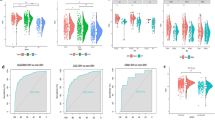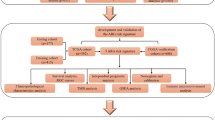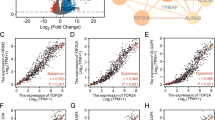Abstract
Advanced age is an important risk factor for the worse clinical presentation of gliomas, especially glioblastoma (GBM). The tumor microenvironment (TME) in elderly GBM (eGBM) patients is considerably different from that in young ones, which causes the inferior clinical outcome. Based on the data from the Chinese Glioma Genome Atlas RNA sequence (CGGA RNA-seq), the Cancer Genome Atlas RNA array (TCGA RNA-array), and gene set enrichment (GSE) 16011 array sets, the differential genes and function between eGBM (≥ 60 years old) and young GBM (yGBM, 20–60 years old) groups were explored. Immunohistochemistry (IHC) was utilized to depict the abundance of CD8+ cells (the main resource of IFN-γ) and IFITM2 protein expression in GBM samples. Furthermore, reverse transcription-polymerase chain reaction (RT-PCR) and Western blotting (WB) were performed to verify the link between IFN-γ and IFITM2. Moreover, the small-interfering RNA (siRNA) of IFITM2 was used to explore the function of IFITM2 in GBM. Characterized by inflammatory TME and higher IFITM2 expression, eGBM harbored a shorter survival time. Chemotaxis and inflammatory cytokine-related genes were enriched in the eGBM group, with more infiltrative CD8+ T cells. The IHC of CD8 and IFITM2-staining could demonstrate these results. In addition, the IFN-γ response pathway was activated in eGBM and resulted in a dismal outcome. Next, it was found that IFITM2 triggered by IFN-γ played a key role in IFN-γ-induced malignant phenotype in eGBM.






Similar content being viewed by others
Availability of Data and Materials
All data and materials used are available from the corresponding author upon reasonable request.
Abbreviations
- IFITM2:
-
Interferon-induced transmembrane 2
- TME:
-
Tumor microenvironment
- GBM:
-
Glioblastoma
- yGBM:
-
Young glioblastoma
- eGBM:
-
Elderly glioblastoma
- CNS:
-
Central nervous system
- CCND1:
-
Cyclin D1
- PUMCH:
-
Peking Union Medical College Hospital
- ssGSEA:
-
Single sample gene set enrichment analysis
References
Arrieta VA, Chen AX, Kane JR et al (2021) ERK1/2 phosphorylation predicts survival following anti-PD-1 immunotherapy in recurrent glioblastoma. Nat Cancer 2:1372–1386
Baker DJ, Petersen RC (2018) Cellular senescence in brain aging and neurodegenerative diseases: evidence and perspectives. J Clin Invest 128:1208–1216
Buchrieser J, Dufloo J, Hubert M et al (2020) Syncytia formation by SARS-CoV-2-infected cells. EMBO J 39:e106267
Chen CL, Kuo MC, Wu WC, Hsu YC, Wu RM, Tseng WI (2022) Advanced brain aging in multiple system atrophy compared to Parkinson’s disease. Neuroimage Clin 34:102997
De Marco M, Basile A, Iorio V et al (2018) Role of BAG3 in cancer progression: a therapeutic opportunity. Semin Cell Dev Biol 78:85–92
Fang C, Weng T, Hu S et al (2021) IFN-gamma-induced ER stress impairs autophagy and triggers apoptosis in lung cancer cells. Oncoimmunology 10:1962591
Feng E, Liang T, Wang X et al (2019) Correlation of alteration of HLA-F expression and clinical characterization in 593 brain glioma samples. J Neuroinflammation 16:33
Guo X, Pan Y, Xiong M et al (2020) Midkine activation of CD8(+) T cells establishes a neuron-immune-cancer axis responsible for low-grade glioma growth. Nat Commun 11:2177
Imai D, Yoshizumi T, Okano S et al (2019) IFN-gamma promotes epithelial-mesenchymal transition and the expression of PD-L1 in pancreatic cancer. J Surg Res 240:115–123
Kim M, Ladomersky E, Mozny A et al (2021) Glioblastoma as an age-related neurological disorder in adults. Neurooncol Adv 3:vdab125
Kohanbash G, Carrera DA, Shrivastav S et al (2017) Isocitrate dehydrogenase mutations suppress STAT1 and CD8+ T cell accumulation in gliomas. J Clin Invest 127:1425–1437
Li G, Choi JE, Kryczek I et al (2023) Intersection of immune and oncometabolic pathways drives cancer hyperprogression during immunotherapy. Cancer Cell 41:304-322.e307
Liao P, Wang W, Wang W et al (2022) CD8(+) T cells and fatty acids orchestrate tumor ferroptosis and immunity via ACSL4. Cancer Cell 40:365-378.e366
Liu B, Ji Q, Cheng Y et al (2022a) Biomimetic GBM-targeted drug delivery system boosting ferroptosis for immunotherapy of orthotopic drug-resistant GBM. J Nanobiotechnology 20:161
Liu Y, Liang X, Yin X et al (2017) Blockade of IDO-kynurenine-AhR metabolic circuitry abrogates IFN-gamma-induced immunologic dormancy of tumor-repopulating cells. Nat Commun 8:15207
Liu Y, Zhou M, Wu J et al (2022b) Interferon-induced transmembrane protein 2 promotes epithelial-mesenchymal transition by activating transforming growth factor-beta1/small mother against decapentaplegic 2 signaling in gastric cancer. Mol Biol Rep 49:997–1006
Ma W, Zhang K, Bao Z, Jiang T, Zhang Y (2021) SAMD9 is relating with M2 macrophage and remarkable malignancy characters in low-grade glioma. Front Immunol 12:659659
Markwell SM, Ross JL, Olson CL, Brat DJ (2022) Necrotic reshaping of the glioma microenvironment drives disease progression. Acta Neuropathol 143:291–310
Matas-Rico E, Frijlink E, van der Haar AI et al (2021) Autotaxin impedes anti-tumor immunity by suppressing chemotaxis and tumor infiltration of CD8(+) T cells. Cell Rep 37:110013
Mathewson ND, Ashenberg O, Tirosh I et al (2021) Inhibitory CD161 receptor identified in glioma-infiltrating T cells by single-cell analysis. Cell 184:1281-1298.e1226
Narayana SK, Helbig KJ, McCartney EM et al (2015) The interferon-induced transmembrane proteins, IFITM1, IFITM2, and IFITM3 inhibit hepatitis C virus entry. J Biol Chem 290:25946–25959
Nchioua R, Schundner A, Kmiec D et al (2022) SARS-CoV-2 Variants of concern hijack IFITM2 for efficient replication in human lung cells. J Virol 96:e0059422
Qie S, Diehl JA (2016) Cyclin D1, cancer progression, and opportunities in cancer treatment. J Mol Med (Berl) 94:1313–1326
Song E, Mao T, Dong H et al (2020a) VEGF-C-driven lymphatic drainage enables immunosurveillance of brain tumours. Nature 577:689–694
Song H, Fu X, Wu C, Li S (2020b) Aging-related tumor associated fibroblasts changes could worsen the prognosis of GBM patients. Cancer Cell Int 20:489
Sun T, Xu YJ, Jiang SY et al (2021) Suppression of the USP10/CCND1 axis induces glioblastoma cell apoptosis. Acta Pharmacol Sin 42:1338–1346
Tatari N, Khan S, Livingstone J et al (2022) The proteomic landscape of glioblastoma recurrence reveals novel and targetable immunoregulatory drivers. Acta Neuropathol 144:1127–1142
Thakkar JP, Dolecek TA, Horbinski C et al (2014) Epidemiologic and molecular prognostic review of glioblastoma. Cancer Epidemiol Biomarkers Prev 23:1985–1996
Wang M, Zhou Z, Wang X, Zhang C, Jiang X (2022) Natural killer cell awakening: unleash cancer-immunity cycle against glioblastoma. Cell Death Dis 13:588
Wang Y, Zhao B, Chen W et al (2020) Pretreatment geriatric assessments of elderly patients with glioma: development and implications. Aging Dis 11:448–461
Xie J, Bi Y, Xu S et al (2020) Host antiviral protein IFITM2 restricts pseudorabies virus replication. Virus Res 287:198105
Xu L, Zhou R, Yuan L et al (2017) IGF1/IGF1R/STAT3 signaling-inducible IFITM2 promotes gastric cancer growth and metastasis. Cancer Lett 393:76–85
Yang N, Liu Z, Pang S, Wu J, Liang J, Sun L (2021) Predicative value of IFITM2 in renal clear cell carcinoma: IFITM2 is associated with lymphatic metastasis and poor clinical outcome. Biochem Biophys Res Commun 534:157–164
Yang Z, Xu T, Xie T et al (2022) CDC42EP3 promotes glioma progression via regulation of CCND1. Cell Death Dis 13:290
Yoneda T, Graham E, Lozinski T et al (2023) Personality traits, cognitive states, and mortality in older adulthood. J Pers Soc Psychol 124:381–395
Zhai L, Ladomersky E, Lauing KL et al (2017) Infiltrating T cells increase IDO1 expression in glioblastoma and contribute to decreased patient survival. Clin Cancer Res 23:6650–6660
Zhang C, Cheng W, Ren X et al (2017) Tumor purity as an underlying key factor in glioma. Clin Cancer Res 23:6279–6291
Zhang Z, Shen X, Tan Z et al (2022) Interferon gamma-related gene signature based on anti-tumor immunity predicts glioma patient prognosis. Front Genet 13:1053263
Zhu C, Chen X, Guan G et al (2020) IFI30 is a novel immune-related target with predicting value of prognosis and treatment response in glioblastoma. Onco Targets Ther 13:1129–1143
Acknowledgements
The authors thank CGGA, GSE16011, GSE163108, and TCGA sets for the data share and the Beijing Shushi company for data and technology support.
Funding
This work was funded by the Beijing Municipal Natural Science Foundation (7202150) and the National High Level Hospital Clinical Research Funding (2022-PUMCH-A-019) for Yu Wang, and by the National High Level Hospital Clinical Research Funding (2022-PUMCH-B-113), the Tsinghua University-Peking Union Medical College Hospital Initiative Scientific Research Program (2019ZLH101), and the Beijing Municipal Natural Science Foundation (19JCZDJC64200[Z]) for Wenbin Ma.
Author information
Authors and Affiliations
Contributions
TYL and XXW drafted the work. TYL and XXW performed the research and analyzed the data. YW and WBM validated the work. All authors read and approved the final manuscript.
Corresponding authors
Ethics declarations
Ethics Approval and Consent to Participate
This research was approved by the Institutional Ethics Committee of the Peking Union Medical College Hospital (PUMCH).
Competing Interests
The authors declare no competing interests.
Additional information
Publisher's Note
Springer Nature remains neutral with regard to jurisdictional claims in published maps and institutional affiliations.
Supplementary Information
Below is the link to the electronic supplementary material.
Rights and permissions
Springer Nature or its licensor (e.g. a society or other partner) holds exclusive rights to this article under a publishing agreement with the author(s) or other rightsholder(s); author self-archiving of the accepted manuscript version of this article is solely governed by the terms of such publishing agreement and applicable law.
About this article
Cite this article
Liang, T., Wang, X., Wang, Y. et al. IFN-γ Triggered IFITM2 Expression to Induce Malignant Phenotype in Elderly GBM. J Mol Neurosci 73, 946–955 (2023). https://doi.org/10.1007/s12031-023-02156-5
Received:
Accepted:
Published:
Issue Date:
DOI: https://doi.org/10.1007/s12031-023-02156-5




